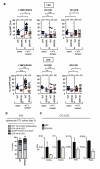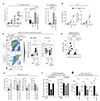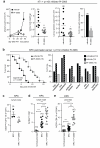Inactivation of PI(3)K p110δ breaks regulatory T-cell-mediated immune tolerance to cancer
- PMID: 24919154
- PMCID: PMC4501086
- DOI: 10.1038/nature13444
Inactivation of PI(3)K p110δ breaks regulatory T-cell-mediated immune tolerance to cancer
Erratum in
-
Corrigendum: Inactivation of PI(3)K p110δ breaks regulatory T-cell-mediated immune tolerance to cancer.Nature. 2016 Jul 28;535(7613):580. doi: 10.1038/nature17641. Epub 2016 Apr 6. Nature. 2016. PMID: 27049952 No abstract available.
Abstract
Inhibitors against the p110δ isoform of phosphoinositide-3-OH kinase (PI(3)K) have shown remarkable therapeutic efficacy in some human leukaemias. As p110δ is primarily expressed in leukocytes, drugs against p110δ have not been considered for the treatment of solid tumours. Here we report that p110δ inactivation in mice protects against a broad range of cancers, including non-haematological solid tumours. We demonstrate that p110δ inactivation in regulatory T cells unleashes CD8(+) cytotoxic T cells and induces tumour regression. Thus, p110δ inhibitors can break tumour-induced immune tolerance and should be considered for wider use in oncology.
Figures








Comment in
-
Cancer: natural-born killers unleashed.Nature. 2014 Jun 19;510(7505):342-3. doi: 10.1038/nature13503. Epub 2014 Jun 11. Nature. 2014. PMID: 24919150 No abstract available.
-
Immunotherapy: PI3Kδ inhibition lifts the breaks on antitumour immunity.Nat Rev Clin Oncol. 2014 Aug;11(8):442. doi: 10.1038/nrclinonc.2014.112. Epub 2014 Jul 1. Nat Rev Clin Oncol. 2014. PMID: 24981255 No abstract available.
-
Anticancer drugs: horizons broaden for PI3Kδ inhibitors.Nat Rev Drug Discov. 2014 Aug;13(8):573. doi: 10.1038/nrd4399. Nat Rev Drug Discov. 2014. PMID: 25082283 No abstract available.
References
-
- Murray JM, et al. Potent and highly selective benzimidazole inhibitors of PI3-kinase delta. Journal of medicinal chemistry. 2012;55:7686–7695. - PubMed
-
- Safina BS, et al. Discovery of novel PI3-kinase delta specific inhibitors for the treatment of rheumatoid arthritis: taming CYP3A4 time-dependent inhibition. Journal of medicinal chemistry. 2012;55:5887–5900. - PubMed
Publication types
MeSH terms
Substances
Grants and funding
- A10200/CRUK_/Cancer Research UK/United Kingdom
- 095691/WT_/Wellcome Trust/United Kingdom
- G0901338/MRC_/Medical Research Council/United Kingdom
- C23338/A10200/CRUK_/Cancer Research UK/United Kingdom
- MC_UP_1502/1/MRC_/Medical Research Council/United Kingdom
- C18270/A12888/CRUK_/Cancer Research UK/United Kingdom
- A12888/CRUK_/Cancer Research UK/United Kingdom
- 14355/CRUK_/Cancer Research UK/United Kingdom
- BBS/E/B/000C0407/BB_/Biotechnology and Biological Sciences Research Council/United Kingdom
- BB/E009867/1/BB_/Biotechnology and Biological Sciences Research Council/United Kingdom
- 12888/CRUK_/Cancer Research UK/United Kingdom
- C23338/A15965/CRUK_/Cancer Research UK/United Kingdom
- 15965/CRUK_/Cancer Research UK/United Kingdom
- A15965/CRUK_/Cancer Research UK/United Kingdom
- BBS/B/02010/BB_/Biotechnology and Biological Sciences Research Council/United Kingdom
- 095691/Z/11/Z/WT_/Wellcome Trust/United Kingdom
LinkOut - more resources
Full Text Sources
Other Literature Sources
Molecular Biology Databases
Research Materials
Miscellaneous

